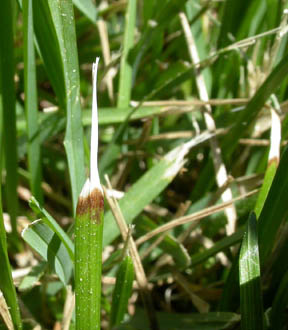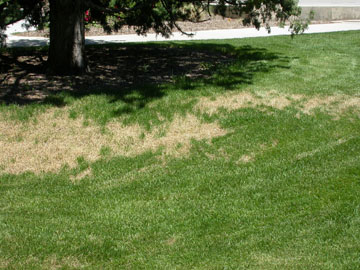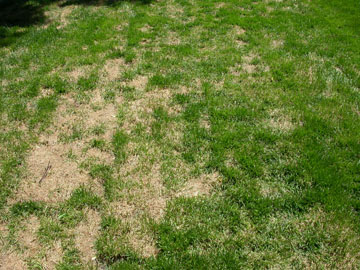by N. Tisserat* (6/12)
Quick Facts…
- Ascochyta leaf blight has become a common problem on Kentucky bluegrass lawns in Colorado.
- Large uniform areas of affected turf will turn straw-colored.
- Leaves usually start dying back from the tips.
- Ascochyta can occur throughout the growing season, but is more prevalent in the spring when there are extended wet periods.
- The first line of defense against Ascochyta leaf blight is to manage the turf properly.
Ascochyta leaf blight is a common disease of Kentucky bluegrass lawns in Colorado. It may also occur on tall fescue and perennial ryegrass. The disease results in rapid development of large, straw-colored blighted areas of the lawn during the summer. The environmental conditions that trigger Ascochyta leaf blight are poorly understood.
Symptoms and Signs
 |
Figure 1: Bleached leaf tips and banding are characteristic of Ascochyta leaf blight. |
Ascochyta leaf spot symptoms may develop throughout the growing season but are more common during hot, droughty periods that were preceded by cool, rainy conditions. Large irregular patches of turf rapidly turn a straw-color and appear dead. The overall appearance of the disease may resemble drought stress, except that the symptoms of Asochyta blight
appear quickly (i.e. sometimes overnight). Although the blighting within an area appears complete from a distance, healthy leaves are interspersed within the patch. Blighting is usually restricted to the leaves; bluegrass crowns and roots typically are not killed.
Leaves infected with the Ascochyta fungus often exhibit a bleached tip dieback that extends approximately a third to halfway down the leaf blade. The margin between healthy and diseased tissue is abrupt and slightly pinched, but doesn’t have the dark brown to purple banding that is characteristic of another disease called dollar spot. In other cases leaves may exhibit white banding or entirely collapse and shrivel. These leaf symptoms resemble heat or drought stress.
The Ascochyta fungus produces minute yellow to dark brown, flask-shaped fungal fruiting bodies called pycnidia in diseased leaf tissue. These fruiting bodies, which are easier to view with the aid of a hand lens, are peppered throughout the dead leaves and can be very useful as a diagnostic feature.
Conditions
Ascochyta species can be found on senescing or dead leaves of several turfgrass species, however the disease appears to be most serious on Kentucky bluegrass.
The Ascochyta fungus likely survives as spores in pycnidia on dead leaves or clippings remaining in the thatch. These pycnidia are highly resistant to drought and extreme temperatures. Thousands of spores may ooze from a single pycnidium during wet weather and be dispersed by splashing rain, irrigation, mowing or other management activities.
Conditions that favor Ascochyta blight are poorly understood. The disease occurs in late spring and summer and appears to be enhanced by soil moisture fluctuations, especially drought stress caused by watering restrictions and poor irrigation system coverage. However, the disease may also develop during periods of hot weather preceded by unusually wet
soil conditions caused by excessive rain or over-irrigation. Frequent mowing and dull mower blades may contribute to disease severity by creating more infection sites (wounds).
 |
 |
Figure 2. Ascochyta leaf blight on Kentucky Bluegrass |
Figure 3. Ascochyta leaf blight. Note that not all of the leaves within a diseased area are blighted. |
Management
Ascochyta leaf blight can be managed by following good cultural practices that minimize stress in the lawn.
- Reduce thatch and promote water penetration through the soil by yearly aerification. Maintain grass height between 2 ½ and 3 inches. Minimize wounding of the leaf blades by maintaining sharp mower blades. Avoid mowing during wet weather, especially when Ascochyta blight is active. Reduce mowing frequency and increase mowing height during Ascochyta outbreaks. Although the fungus can be spread from one location to another on grass clippings it is unlikely to contribute significantly to disease development because the fungus is already present throughout every lawn. Similarly collecting clippings while mowing to reduce the amount of fungus is unlikely to reduce disease severity. The disease is more likely
intensified by environmental factors and not the quantity of fungus present. - Maintain a balanced fertilization program. Follow Colorado State University recommendations. Avoid excessive applications of nitrogen fertilizer, especially in spring. This promotes rapid, succulent leaf growth that requires more frequent mowing (hence wounds).
- Try to maintain uniform soil moisture. Check the irrigation system to make sure all irrigation heads are working properly and that water is being distributed uniformly to avoid drought stress. On the other hand excessive irrigation and poorly drained soils may also promote disease development.
- Ascochyta blight is primarily a leaf and not a root or crown disease so it rarely causes plant mortality. Turfgrass usually recovers completely after a couple of weeks. Although several fungicides will inhibit Ascochyta growth, they can be expensive and difficult to apply. Furthermore Ascochyta leaf blight development is sporadic and rapid, making timing of preventive and curative fungicide applications difficult.
Remember that Ascochyta blight is primarily a foliage and not a root or crown disease. Therefore individual bluegrass plants are usually not killed. Given enough time, usually several weeks, depending on weather, new leaves will emerge from the surviving shoots. Be patient following a disease outbreak and maintain normal management practices.
1 N. Tisserat, Colorado State University professor, bioagricultural sciences and pest management department. 10/92. Revised 6/12.
Colorado State University, U.S. Department of Agriculture, and Colorado counties cooperating. Extension programs are available to all without discrimination. No endorsement of products mentioned is intended nor is criticism implied of products not mentioned.
Go to top of this page.





